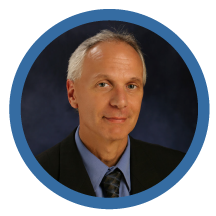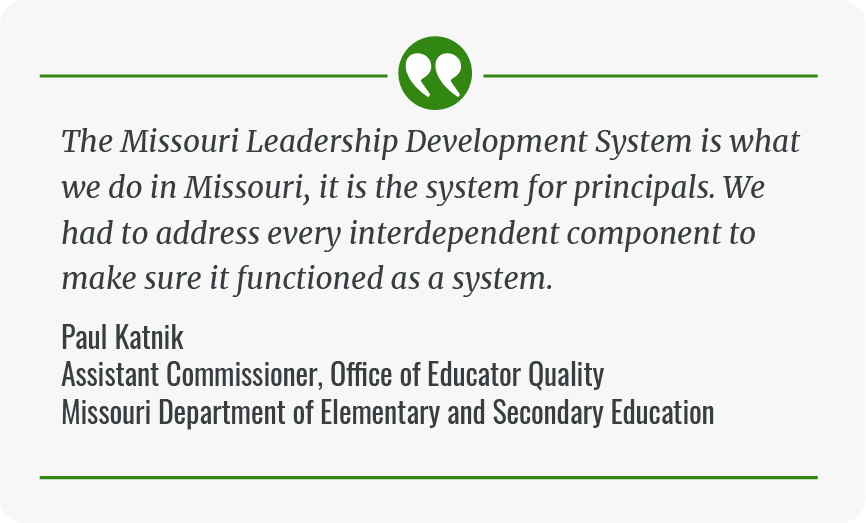Voices from the Field spotlights stakeholders in Region 12 and their work to improve educational opportunities and outcomes. R12CC is privileged to collaborate with and share the insights of Paul Katnik, Assistant Commissioner, Office of Educator Quality at the Missouri Department of Elementary and Secondary Education (DESE).

What is the Missouri Leadership Development System?
The Missouri Leadership Development System (MLDS) is a progressive and intentional system of learning and support for Missouri principals. Initial work on the program began six-and-a-half years ago. It took a couple of years to get the competencies developed and the program designed, and Missouri is now heading into its fourth year of full implementation. MLDS was developed as a continuum because when you talk about principals, you are really talking about those who are studying to be principals, those who just became principals, principals who are past the first couple years but are still learning a lot, and the principals who have done this for a while. The four MLDS levels are Aspiring, Emerging, Developing, and Transformational. We quickly learned that we had to have learning for a principal at each level, because what a Transformational principal needs is different than what an Emerging principal needs and so on.
During the development of MLDS, we thought about the different hats that principals have to wear and created five domains: Visionary, Instructional, Managerial, Relational, and Innovative Leadership. Everything that a principal needs to know or do falls into one of these five domains. The domains are further defined by competencies for a total of 32 competencies across the five domains. The learning, training, and support was developed so that no matter where a principal is, in any of the domains on any competency, and anywhere in their professional career—whether they are brand new or they have been at it for 20 years—we have learning that helps move them to higher levels of performance. The overall goal for DESE is to reach all principals in the state—about 2,200 principals and 1,300 assistant principals.
How was MLDS developed?
The key letter in MLDS is the “S” for system. When you want a system, not a training program, you have now invited yourself into the world of interdependent parts, components, and pieces. MLDS was designed to function at lots of levels, in lots of places, and in lots of ways, which is why the “S”–system–is really an important word.
To develop content, we coordinated with the 23 higher education programs across the state that train principals. DESE provided training and gave these programs the content so that on every campus, if you are learning to be a principal, you are really learning about MLDS. The next step then for principals is certification. Before the principals leave their higher education program, the internship activity they complete is based on MLDS. Then they get the certificate, which is also based on MLDS.  Next, principals are required in the State of Missouri to have two years of mentoring, and those two years of mentoring are based on MLDS. When it is time to upgrade their certificate from an initial to a transition after four years, and from a transition to a career at the 10-year mark, the upgrades in certification are based on MLDS. Micro credentials were also built in based on MLDS. The way a principal gets an upgrade to their initial certificate is they either work on a specialist degree or now they can earn micro credentials. MLDS now has 15 micro credentials and if a principal gets three of them, they receive their transition certificate. If they get all 15, they get their career certificate.
Next, principals are required in the State of Missouri to have two years of mentoring, and those two years of mentoring are based on MLDS. When it is time to upgrade their certificate from an initial to a transition after four years, and from a transition to a career at the 10-year mark, the upgrades in certification are based on MLDS. Micro credentials were also built in based on MLDS. The way a principal gets an upgrade to their initial certificate is they either work on a specialist degree or now they can earn micro credentials. MLDS now has 15 micro credentials and if a principal gets three of them, they receive their transition certificate. If they get all 15, they get their career certificate.
The whole point is that if it is truly a system, then anywhere you look, you are going to see MLDS—it is what we do in Missouri, it is the system for principals. We had to address every interdependent component to make sure it functioned as a system. Otherwise, it would simply be a standalone training.
What is the role of specialists in MLDS?
MLDS specialists deliver the training and support to the principals and assistant principals in their region. This year we are expanding our team of specialists from 17 to 26. Specialists deliver MLDS both in-person and online, and it takes all different kinds of configurations based on the needs in the region. For example, in the St. Louis region, our specialists are able to do more in-person and onsite trainings because they are within one city. But if you are a specialist in the Northwest region, you cover multiple counties and hundreds of miles so you may do more training in one location. Delivery of MLDS is contextually based, but the training and learning provided is all the same.
DESE invested considerable time and money making sure that all our MLDS specialists present MLDS content the same way. What I think makes MLDS different is not just how we designed the content, but two other foundational parts that are as important, if not more important. One is adult learning theory. We make sure that our specialists are very well versed in adult learning theory and understand that they are not just sharing learning with any adult, but principals who have a very distinct role in their communities and a very distinct daily pace. The other part is the specialist’s facilitation skills. For a very busy principal, if they leave a training room and do not feel like it was worth their time, we will never get them back to a training. Specialists must be very proficient in facilitating training and learning and know who their audience is. We invested over 100 hours preparing our specialists to know the content, to be good facilitators, and to really understand how adults learn so that every hour a principal spends with MLDS they will feel is time well spent.
What role do partners play in MLDS?
MLDS was built with a coalition of partners. Everyone had to be on the MLDS bandwagon. Our partners are the 23 principal preparation programs, our principal associations and superintendent association, the education administration association, our State Board of Education and Commissioner, and our regional professional development centers located across the state. Every partner played a role in creating the system. We developed the MLDS Commission to provide input on the governance of MLDS and every partner has a seat on it. That group meets quarterly to look at the system and think about what is working well and what is next to come.
When the pandemic came along, because we are the state system of learning and support for principals, MLDS had to have an appropriate response. Our response led to the creation of online modules and podcasts that principals could watch and listen to from home, from quarantine, from wherever and whenever worked for them. We did not plan for that in the beginning, but these resources are now out there and getting used. As a system, we must always be responsive to new conditions and context, whenever and wherever they come up.
How has Region 12 Comprehensive Center supported MLDS?
When the newest Every Student Succeeds Act was passed, it included a provision that allowed a state agency to keep an additional three percent of Title IIA funds to be used for leadership development. We already had the idea for MLDS, so we talked to all our superintendents around the state about retaining and using these additional three percent of funds to put the idea in motion. Every superintendent we talked to said, “yes, go ahead and do it, this is needed, but you need to do it right.” The promise was made before we even got started that we are going to do it well or we will stop and return those three percent of funds. There is an obligation to all these people to do it right. This means that we must be very intentional about evaluating MLDS.
Each year a different aspect of the MLDS program is studied and evaluated. We always administer surveys that ask basic questions, such as do people find it valuable? Are they using it? We also ask more in-depth research questions to study and understand MLDS from different angles and perspectives. For example, looking at the program from the superintendents’ lens, what do they think about MLDS? While we want to hear from principals who are in MLDS, we also want to know what that principal’s boss thinks. This year, we are researching the program from the teachers’ perspectives. If you are a teacher of an MLDS principal, is your experience different than if you are a teacher of a principal who is not in MLDS?
At DESE, we are too invested in the program to take an objective look, so we need external people to evaluate it for us. We need someone who has no investment in MLDS to come and flip over every rock to see what’s underneath—and if it is lousy, they will say it is lousy, and if it is great, they will say it is great. That is where the Region 12 Comprehensive Center comes in.
There are two big comprehensive external evaluations completed and we are working on our third. With this independent evaluation, we can say to people, “Here’s what they think about MLDS, not what we think.” If any of the superintendents were to come back to me today and say, “Look, you’ve been using this money for a couple of years, how do you know what you’re doing is working?” I can take them to our webpage and share the external evaluation reports that are posted and made public. In this way, the Region 12 Comprehensive Center has been very valuable to us. We will continue to evaluate MLDS every single year—it’s our obligation because we agreed to do it right.
